To know Ed and Deanna Templeton requires intense admiration of their twenty-five year relationship. And if familiar with either of their photographs, you’ve likely had already a look into their life together.
Ed has, almost compulsively, documented their life together. He’s shown us the challenges and elations of young marriage, the loss of a parent, concussions and injuries, the delight of friendship, and most intimately: love and sex. Aside from taking central focus in Ed’s work, Deanna has been creating her own narrative that concentrates of her external world. Deanna quietly but provocatively calls into question topics of identity, body image and private versus public space. Like most-things-Templeton, this balance typifies their relationship; his realism to her optimism, his quick snap to her “May I take your photograph?”
From their book-lined living room, deep in Southern California suburbia, Ed and Deanna shared thoughts on everything from personal inspirations to marriage to camera preference.
This story is featured in our second book, Freunde von Freunden: Friends, order within Germany here, or find the book internationally at selected retailers.
This portrait is part of our ongoing collaboration with ZEIT Online who presents a special curation of our pictures on their site.


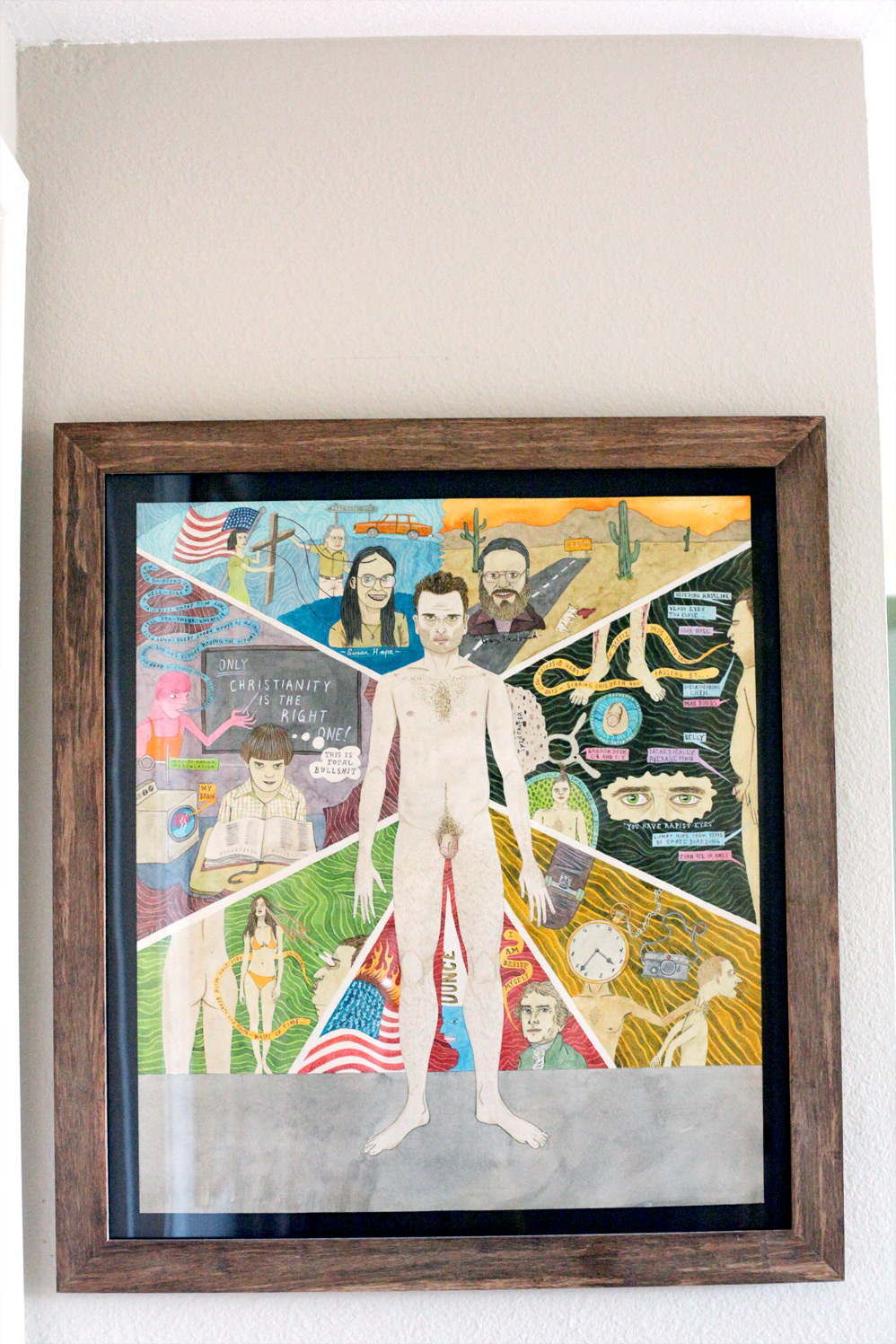






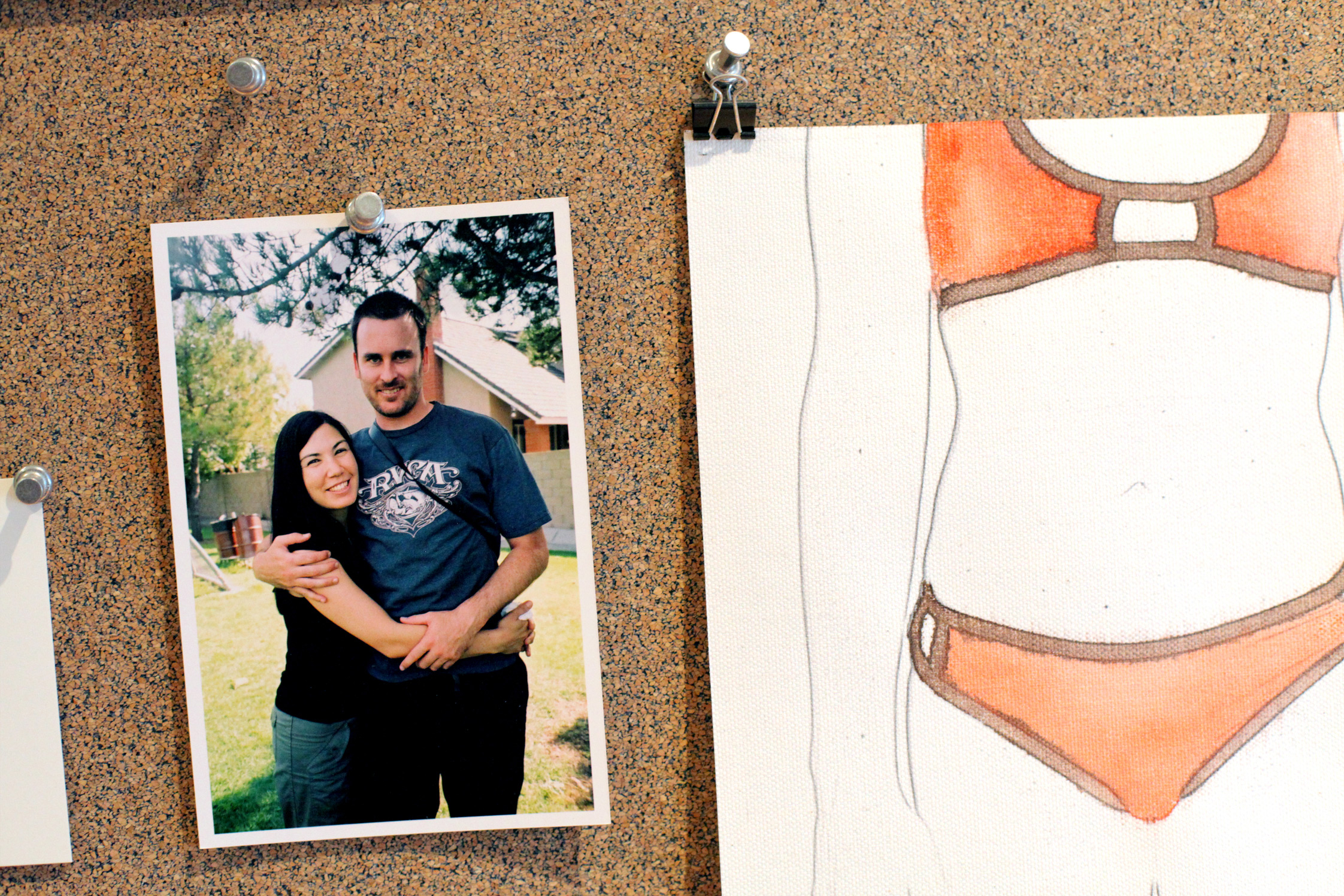


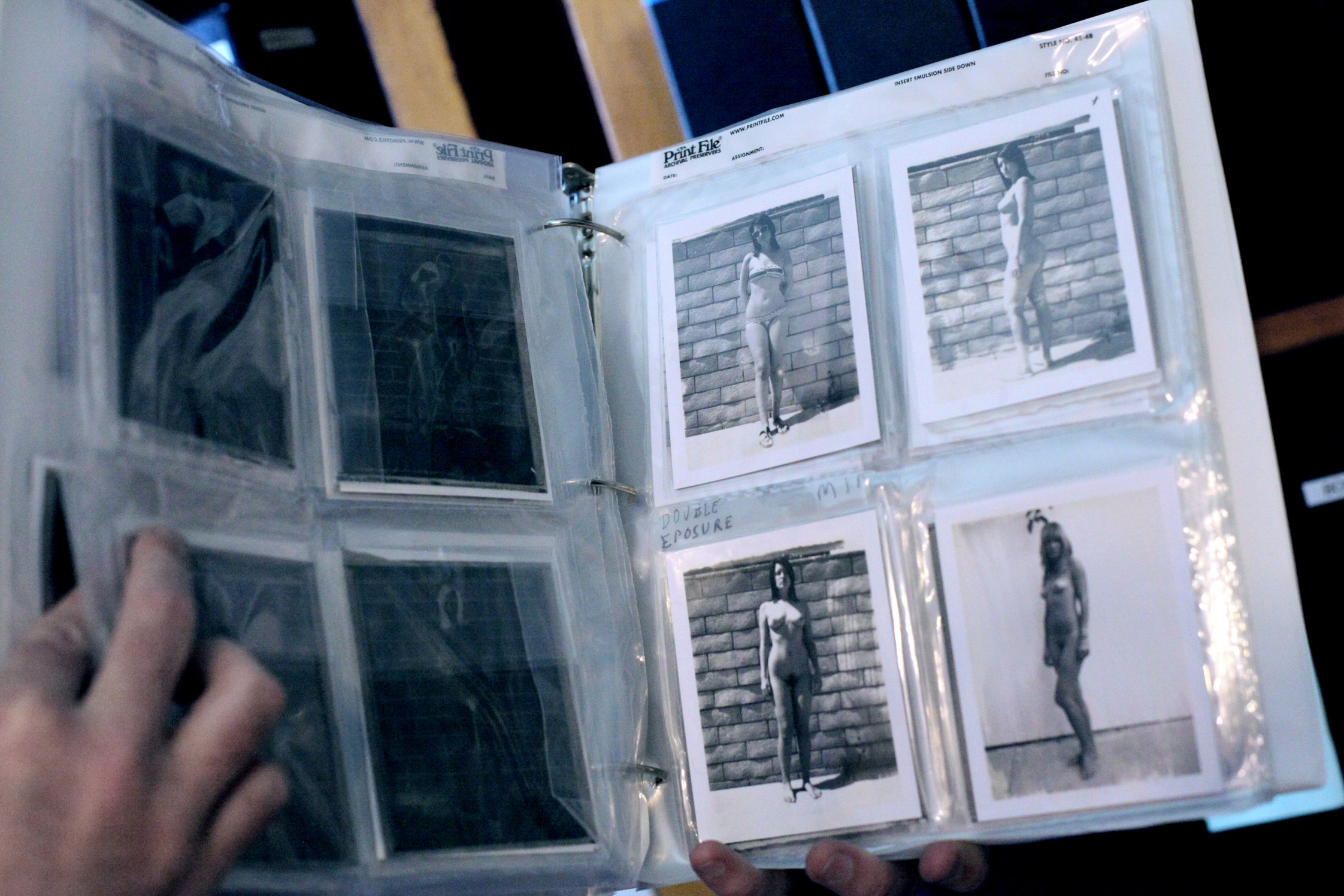





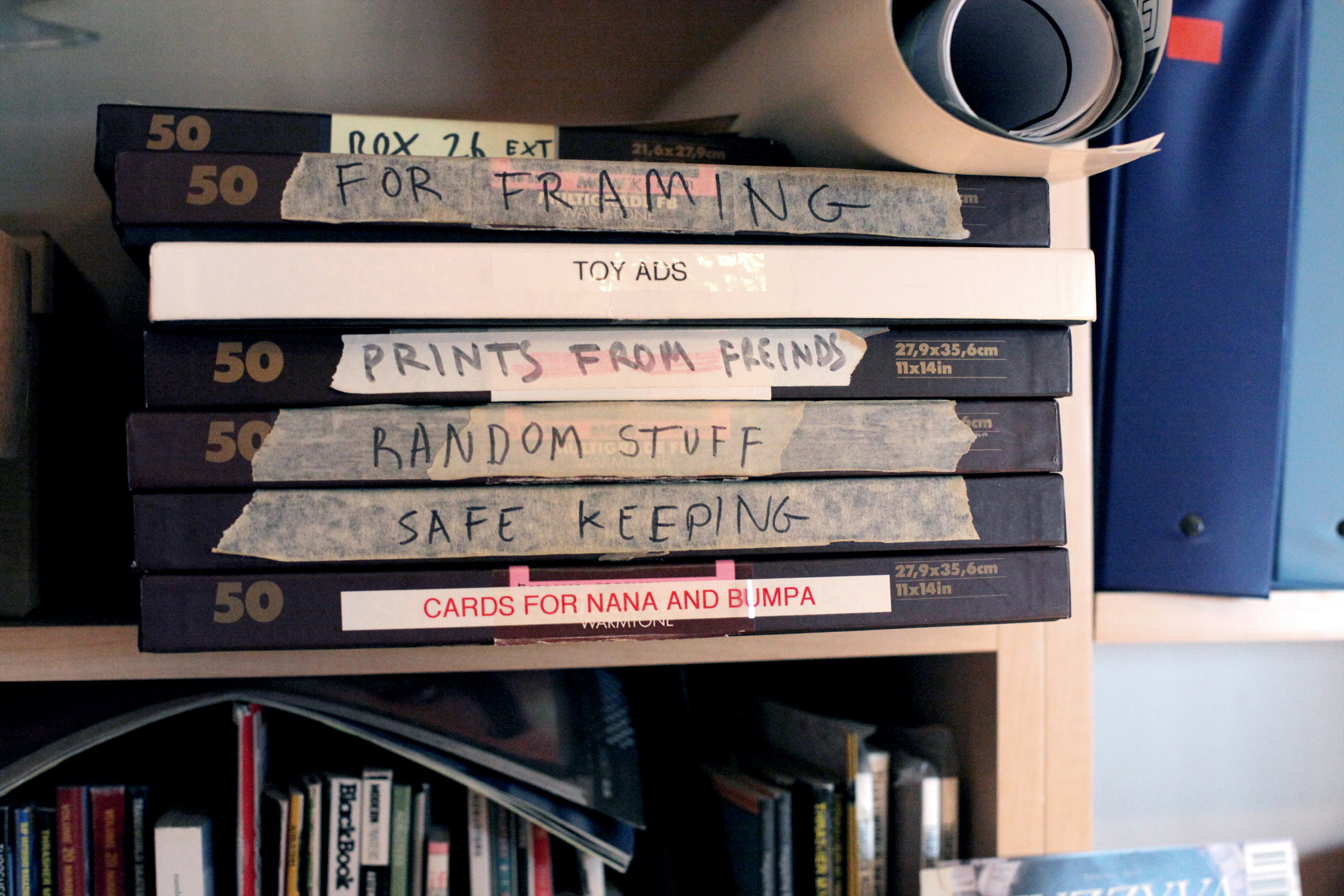







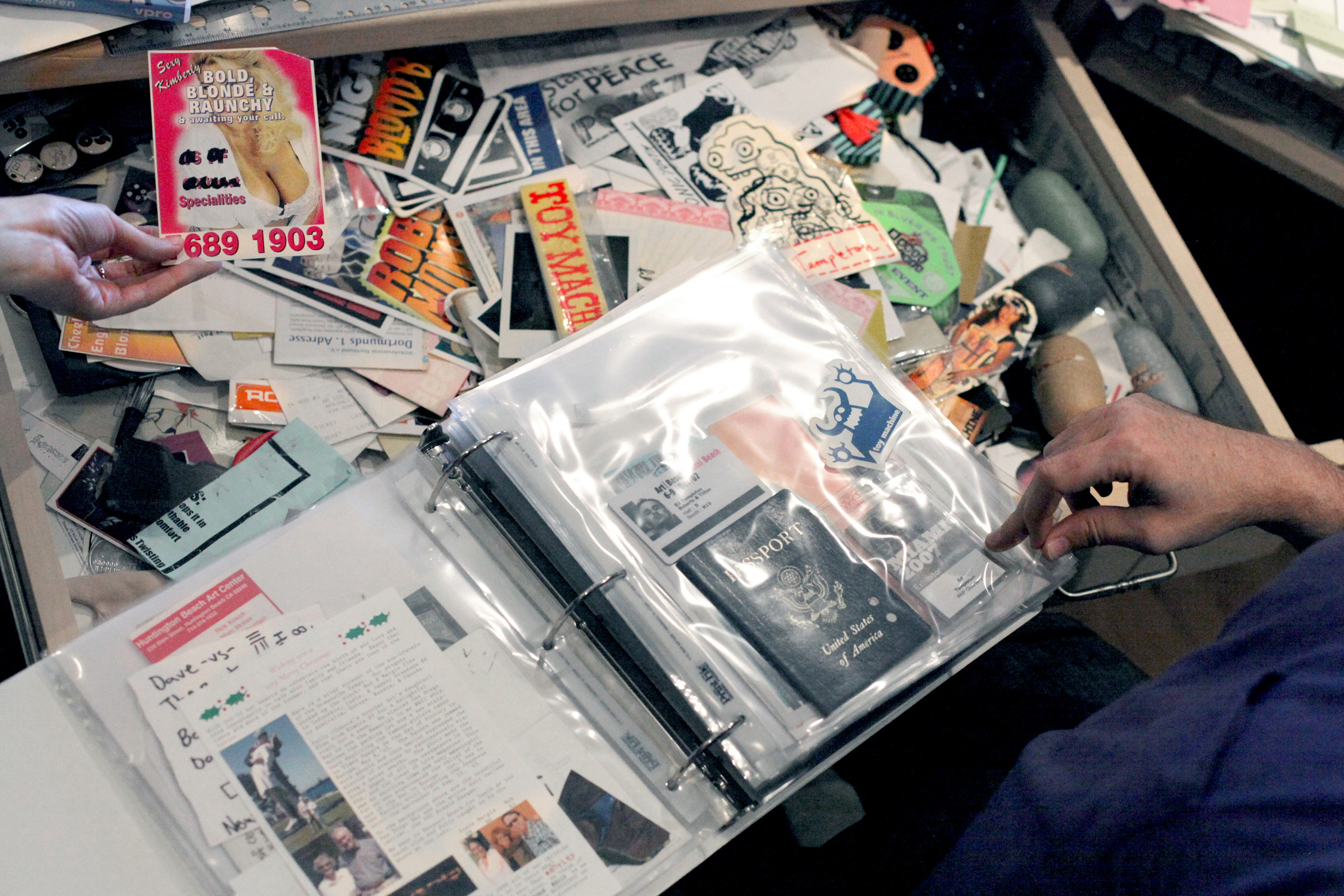



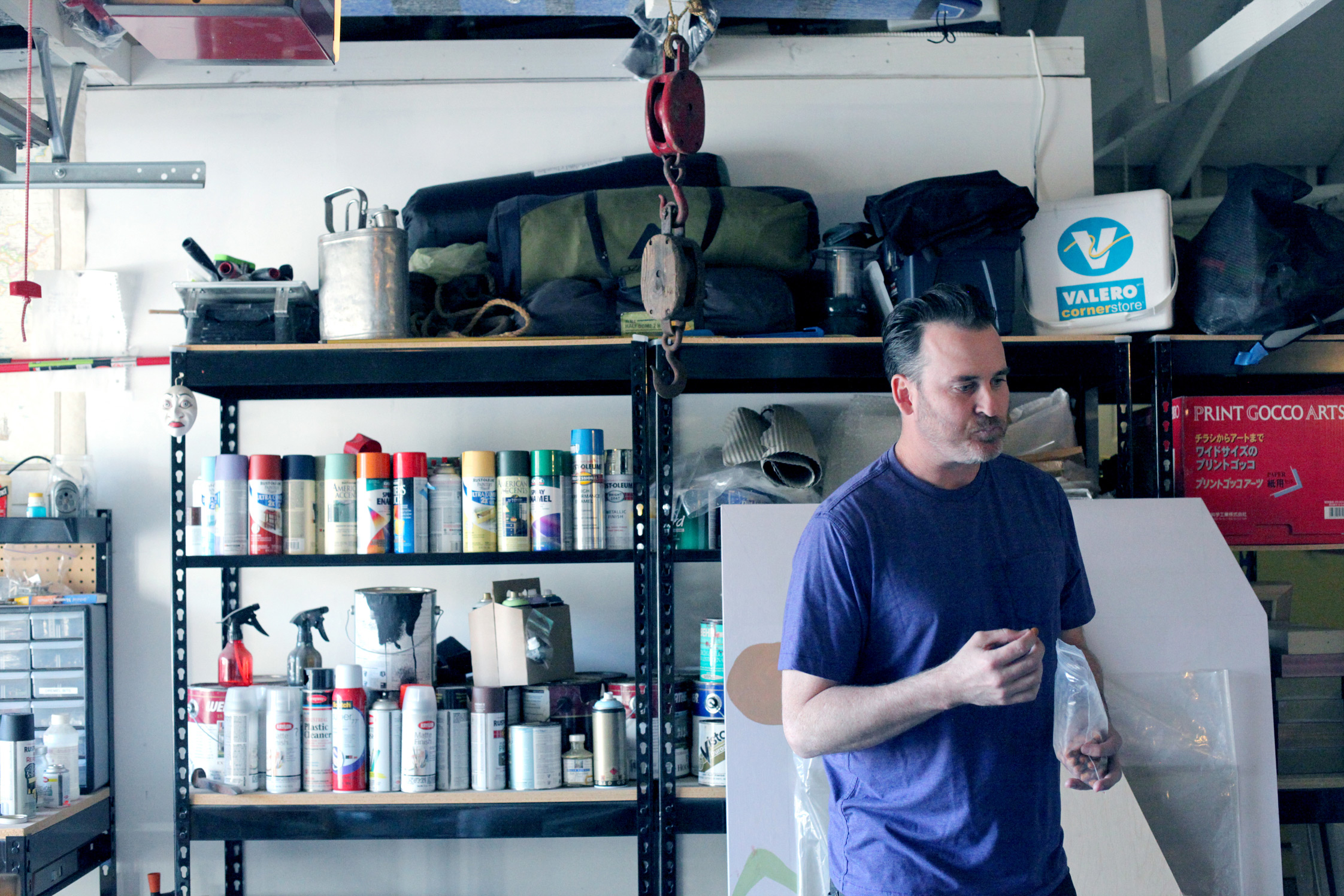








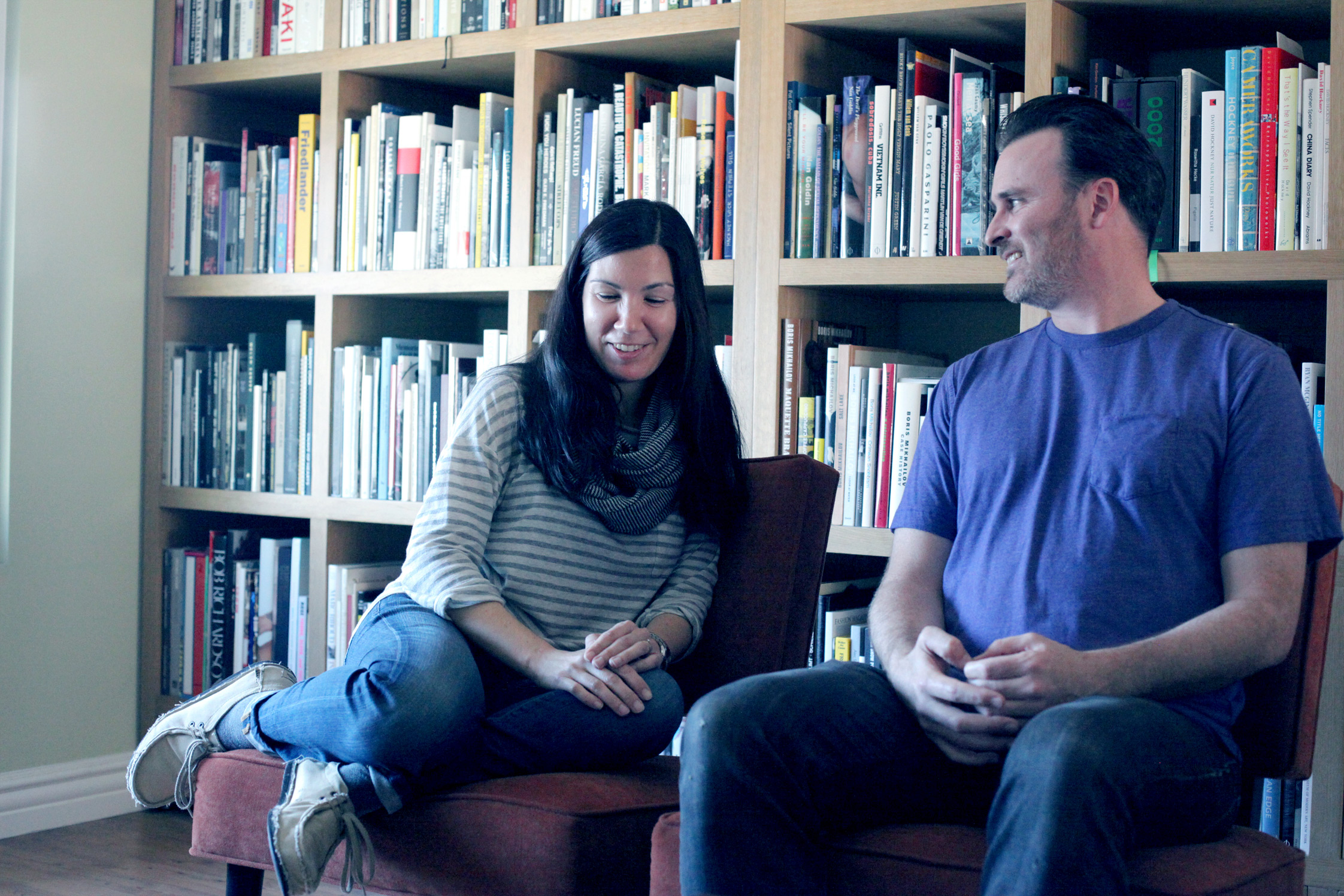




















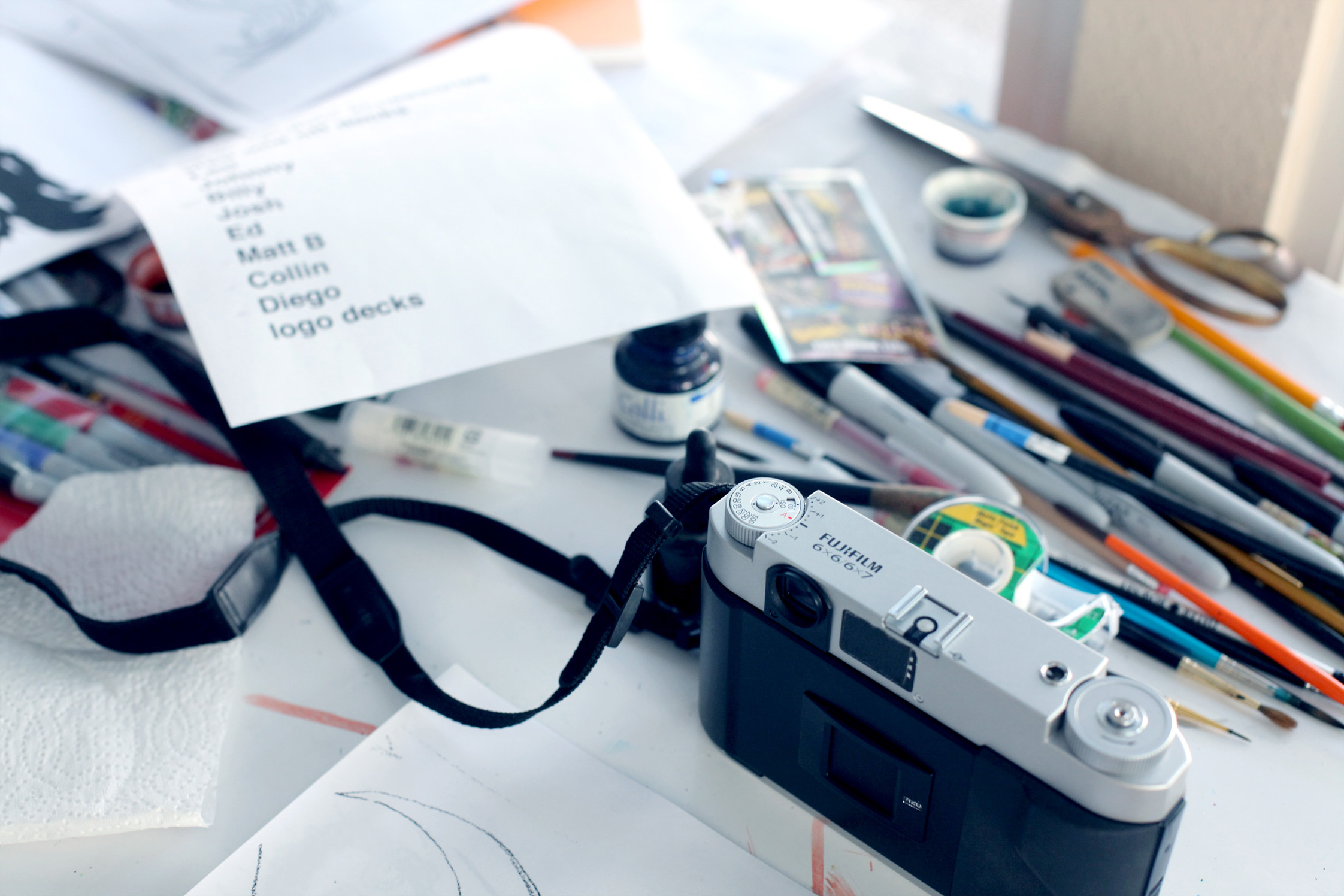
Why don’t we start off with something autobiographical?
Ed: Okay. My name’s Ed Templeton. I grew up in Orange County, California, where I still reside today. I’ve spent most of my life– since 18– as a professional skateboarder. In between that time I also started a skateboard company and have become an artíst of some kind– or at least pursued artistic endeavors through photography and painting to some kind of variable success. That’s what I continue to do today.
Deanna: I’m Deanna Templeton. I floated around, pretty much, until I was 18 and met Ed, just going to concerts and hanging out with my friends and going to school. I got interested in photography when I was about 16 or so, until I had my camera stolen on a flight to Mexico and then didn’t find it again until Ed put a camera in my hand on my 21st birthday. And ever since then, still floating around, assisting Ed with whatever he needs done and figuring out my own path as a photographer.
You guys have a really interesting relationship because you’ve been together so many years. You work so closely together, travel together and spend the bulk of your time as a pair.
Ed: Well, I think for most people our relationship would be claustrophobic. I have a lot of friends who I watch take very specific free time from their girlfriends, or vice versa. I was thinking, “You know, I’m never away from Deanna.” We’re together all the time.
Can you talk about how you met?
Ed: I met Deanna through my best friend at the time [Jason]. His girlfriend, Ann, had a best friend in Deanna. We all skipped school to see a Red Hot Chili Peppers concert in LA.
An afternoon concert.
Ed: So yeah, Ann brought her friend Deanna in the car and Jason and I were sitting in the back seat, checking out the girls in front, like “who’s this new girl?” And that was kind of it. The girls went to try to see the concert and Jason and I took off trying to skate around L.A. We took it as an opportunity to try to go skateboarding. I would see Ann all the time because she was always hanging out with Jason. I think she said “Deanna thought you were cute,” and that was it. I think I said, “Get something together!”
What year is that?
Deanna: ’87. Ed was 15 and I was 18.
Ed: Ann set up a double-date. We went with Jason and Ann to see Fatal Attraction at the movie theater. I had acid wash jeans on with an acid washed jacket. And I was trying to cultivate a scum stache at this point, which wasn’t really growing.
Deanna: And you had braces.
Ed: And I had braces….
Deanna: And some zits.
Ed: Yeah braces, zits…
Deanna: And you had hair that covered your eye.
Ed: Skate-do… Bangs coming down…
Deanna: And he was amazing! He was so cute!
Ed: And I think after the movie– I was real amateur at girls– I thought, “This is my last chance!” As we were leaving I started going in for a kiss and fully missed. I was so scared of everything that I fully missed and kissed her semi-cheek. It ended up being kind of cute because I blew it so hard.
Deanna: That was our second date, and then our third date we went out skating…
Ed: The third date was just that we went out skating and the girls were following along.
Deanna: Following? We were the ones who drove you guy there.
Ed: Actually, yeah. We were teenage deadbeats. Deanna had a car, so they would take us around skating. We were skating some bank and I think I said, “So, are we boyfriend-girlfriend now?”
Deanna: You sat down and said, “So, am I your boyfriend now?” I looked over at Ann and she shrugged her shoulders and I looked back and Ed and was like, “Sure.”
It’s amazing, because you guys grew up together.
Deanna: I taught him how to drive.
Ed: It’s a really strange kind of thing because I don’t know what things force people apart, at what stages, but we definitely had the fights that you know — the kind of tumultuous relationship you would have at that age — with like, heavy fights, near breakups and stuff. Whenever I see anything happening, I’m the kind of person that just wants to tackle it and deal with it right away. I mean, I think some of the fights that have happened have been me just not letting it go, have it air it out and get it figured out right now. And I think as a process that would help us put everything on the table always.
That’s interesting– that’s also a huge part of your process to as an artist, exposing as much as possible, constantly.
Ed: It’s something that I — regret’s not the right word — but I’m reinspecting as I go further. Like the fact that all of my work and everything about our relationship has been like an open book for everyone to see and look at and try to use as art, in a way. I feel like there’s mixed results with that sometimes. I almost wish I had been a little less open.
But it was probably more therapeutic than anything. I think a lot of what you have created has been not for the sake of creating artwork, but more about a release.
Ed: There’s definitely been part of that too, for sure. On the other side, yeah. Working the other way around. I never thought about it that way. That the act of using it in that way helped the relationship be strong. I never thought of it that way.
Do you feel like you guys have ever had a talk about the project and the relationship? Like, “This is how I see my life, do you want to be part of it?”
Ed: Yeah, I think at some point early on. I joke sometimes that staying together was just to spite my grandfather who was telling me, “Don’t get married at 19! What are you doing? You’re crazy!” And I’ve always just wanted to prove to him that, “I’m different than what you think. I’m different than all of these statistics you give me. I’m going to be the exception to that rule.” I don’t think him saying that guided it, but probably in the back of my mind there’s that. I wanted to prove it, but it really just boils down to choices. From the guy’s side it would be like, you’re just a person and you think, “What am I missing out there? What if I just stayed with one girl the whole time?” But I always went through that in a very analytical way – pro-con type thing – and it always came out like, “Building a relationship has so much reward in it.” I see friends and the people around me going through all of these things that I don’t ever have to deal with. That’s kind of nice, you know? And it’s like, okay, my sex life is fine, everything’s fine, and there’s that conundrum of, “Is the delivery worth the load?” There is a delivery cost. There’s a cost involved in staying together. But then in theory, the benefit is better. I think of these song lyrics all the time, this Johnny Cash song – it leaves you if you don’t care for it – talking about a relationship. You have to care for it to make it work. You have to try. We liked the idea of, “Let’s be married this whole time. Let’s be that old couple that’s together forever.” Ultimately, the only ingredient that matters is that we never fell out of love with each other.
Deanna’s also been your muse in a very traditional sense…
Ed: And anchor. There’s an anchoring thing.
Sure, but there’s also a lot of trust in that relationship because so many of your intimate moments are exposed.
Deanna: Definitely when he first starting shooting photos of us, I wasn’t thinking that this was going to end up on a wall, this wasn’t going to be displayed in a book — that anyone else was going to see these images besides us. But one of his friends did see some of the photographs and thought they were really beautiful images. I don’t know if Ed directly came to me and said “Hey, I want to put these up.” I could just tell that the idea was already floating around, and in the beginning I just kind of took myself back from it. I trusted him. I knew he wasn’t there to exploit us. Being with Ed already, I think things just fell into line without talking about, “This is how our life is.” Things just developed naturally with his work and what he would show. I think I knew if there was something I really wasn’t comfortable with, it wouldn’t be shown. When his show’s started happening, I wouldn’t stand next to images. I used to make it a point to come fully covered to his openings — I had gloves on, turtleneck — it was just like I was there to support him, I was excited about everything. I really didn’t see me or us in these images; I wouldn’t stare at them. And my whole point the entire time in taking these pictures — or taking these intimate shots — was for us, when we’re 80 — because I do hope with all my heart that we are together for the rest of our lives– when we’re old, we’re going to look back at these and it’s going to be amazing to look back at how we were when we were 18, 19, 20 year olds. How we interacted, how we were intimate.
Ed: Us without all that flab.
Deanna: No, but nowadays, kids are using their cell phones. The intimacy isn’t there. It’s just to show and shock and brag. That’s not where any of this, I believe is coming from. I have to admit that now with all of this imagery that’s out there– when there’s a show and he’s selecting work for a cluster, I do kind of wish we could take it back to just us now. It’s like, everyone else has gotten so out of control, I don’t want to be a part of that. This is something beautiful between us. I would never tell him not to put something in because he needs to do what he needs to do, but I think he’s come to that too. We both kind of like, “Do we want to put that out there?”
Ed: Yeah, I guess in retrospect, some of that might be a little embarrassing. It shows immense trust in her that she would see my sincerity and let me put that kind of stuff in, especially because if you know Deanna, she’s not the person that sometimes comes off in those images. She has had people who come up and ask her strange questions, basically hitting on her, once they recognize her has the person in the photographs. I think sometimes the photos lend this idea of, “This couple’s crazy” or ,”This girl’s crazy,” and if you know us we’re not. We’re not exhibitionists. Neither of us consider ourselves “supermodely.” So it’s not like we’re bragging about our hotness in anyway. People see the photos and think that you’re some kind of sex kitten…
Deanna: But I am with you.
Ed: Yes, but it shows crazy trust. The photos aren’t of us in crazy sex getups or anything like that. There are some funny ones… But those kind of things are the things that happen in a relationship. And that’s what I’m going for when I shoot. As someone who decided that I’m going to carry a camera around a shoot, there would be certain moments in my own relationship, where I would kind of step back and laugh and go, “This is ridiculous” or, “This is funny” or, “This is beautiful and sexy and how can I shoot this?” And sometimes it does kill the whole mood and situation.
Deanna: Yes!
Ed: I’m taking that risk of ruining it, so there’s a dedication that comes to documenting in that serious way. Some of it’s funny, like [the photo of] the exercise ball with the dildo taped to it. Any couple might try some stupid stuff like that. I think I even wrote “failed experiment” [on the photograph], because it didn’t work. But at one point I stepped back and was like, “Look at how fucked up this is! That’s such weird object right there!” I love that photo. And anyone who sees it goes, “What are these people trying?” But anybody who’s in a relationship does this kind of stuff — hopefully this is a shared experience that people in a long-term relationship will recognize. And the fact that I was able to step out and get [the shot] and then share it. I think there’s value in it, and that’s why I guess I’ve done it in the past. The photo’s funny on one level, but then you start thinking about it, and it’s like, “Woah, this is weird.” And sometimes these are the mixed signals that get weird. People see that and think we’re freaky or something, when in fact we’re pretty normal. We’re not anymore freaky than anybody in a relationship — or maybe we are — maybe I’m delusional. Maybe everyone’s just doing it missionary style.
Maybe you’re educating people around the world.
Ed: Yeah– try some new things!
It’s remarkable that while you’re together all the time and often photographing the exact same thing, it’s always easy to identify either of your photographs. Even if it’s not a posed or confrontational image, there’s always something that’s more sensitive about Deanna’s work…
Ed: You’re explaining it perfectly. I’m meaner.
…versus Ed’s which is… What’s the word?
Deanna: Agressive?
Voyeuristic.
Ed: For sure.That’s the best way to put it. I’m a people watcher and I think that comes through. I truly think the thing that the photographer’s thinking comes through in the photo. Even if I change my thought to something else and I’m shooting it, I feel like that comes through to a certain extent. To a sensitive viewer, they’ll see where I’m coming from a lot of times. Even if Deanna and I were to shoot the exact same thing, everything is different about it because she’s more sensitive and more caring and the stuff that she thinks about when shooting the photo — she’s coming from a different place. I always thought she should do a book called The Sentimental Junkie, which is a play on Araki’s book, The Sentimental Journey. And then there’s height difference. And my approach is a lot more confrontational, even though I try to avoid people. I’m definitely looking at things in a more antagonistic way, at people and things. I’m kind of drawn to this more pervy…
Or critical?
Ed: … or critical, sort of harsher, meaner view. I’m trying to make a statement coming from my specific my world view. And although we’ve been together so long, I think our world views are way different.
Deanna’s a little bit more objective, maybe?
Ed: Yeah, it’s true.
The majority of your images come from your own neighborhood [Huntington Beach], but you’re always traveling. There’s a combination of regionalism and globalism in your imagery.
Ed: It’s always been a sort of love-hate relationship, living here. I think for both of us, there’s something that we both chagrined at some point, where we didn’t like it here. I know for me, personally, I rebelled against downtown Huntington Beach when I was younger. I hated all the people here, but then over years I realized that I am one of the people here. I’m part of this culture exactly — I’m a skateboarder from Huntington Beach. How stereotypical is that? I am this guy and the only thing that changes me from these other people is that I’ve had the chance to see the world and widen my world view so much, and learn. Each time we travel and come back here I think both of us are taken aback by like, “Man, look at this place where we live. This is gross.” But as we’ve gotten older, I think there’s an embracing of it, like, “Yeah, we live here, in the jacked suburbs. Let’s use that as some kind of fuel for what we’re doing too. Let’s document the fact that we live in this weird place. It’s incredible.” And it’s kind of funny because on this other level, it’s like, paradise at the same time. I talk to people in places I think are great — Copenhagen, Berlin — and they’re like, “Where are you from?” and we’re like, “Southern California,” and they’re like, “Oh my God, I would love to live there!” And I realize that the rest of the world would die to live here, and we just live here by chance, by luck, we were born here. Parking’s easy, the beach is really close, the weather’s always perfect.
Deanna: I think it’s good down time too, considering we travel so much.
Ed: And we’re away from all of those centers. We always think about living in L.A. or New York or Berlin… But there’s breathing space here. We’re not in the art world at all. And part of what made us what we are is here. Leaving that might change that balance.
Deanna: I just think this is a great place to take a break, to pull back. As much as people talk about Orange County being “Behind the Iron Curtain” and completely Republican — which is true —
Ed: When we’re at home we’ll take day breaks and go to the beach for a walk, but otherwise, we’re at home working anyway without outside distractions. Well that’s the one change, we grew up hating downtown and that scene and now we kind of love it and go to all the time.
Where’s your favorite place to take photographs in Huntington Beach?
Ed: Over the last year it’s been the pier. We just walk on the pier and it narrows down to this one sidewalk of people. Everyone has to walk in this relatively close proximity and the fact that we go down there almost everyday to take a walk has given us this weird insight — totally voyeuristic, where we notice the changes, like, “That guy’s still there.” There’s always this guy there and that guy there and these people. We’re starting to photograph these people over and over. You feel like an anthropologist almost.
And do you have an equivalent outside of Huntington Beach, where you find yourself revisiting the same location?
Deanna: Absolutely — London at night.
Ed: We have a walk in London that we do. Basically, it’s like walking from Downtown London to The Tate. This walk is so, kind of, meandering. Even on the days we don’t go to The Tate, we end up doing that walk, because it’s just such an incredible walk, there’s people everywhere.
Deanna: I think my favorite though is nighttime in London because I like chasing down girls in high heels and miniskirts– because I love shooting legs and shoes.
Ed: Yeah, she’ll stop girls — English club girls. We’ll be walking behind them for a couple blocks.
Deanna: Until we get to where there’s nice lighting coming from some window so you can actually get a photo, or some car light.
What’s each of your favorite camera to shoot with?
Ed: A Leica.
Deanna: I have to say a Leica. And I can’t say just one. I love the new Fuji Film GF670.
Ed: I have one too. We both have the same one.
Which artists, photographers and otherwise have been most influential to each of you?
Ed: I definitely have a couple people that have been super influential, that are like — I partly don’t like to admit it in a way — but then if you see my work, it’s so obvious. Peter Beard is one person that’s a photographer but also a diarist. He spent a lot of time painting on photographs. That’s been super influential. But there have been a lot of people that have painted on photographs that I have enjoyed through the years. Robert Frank is someone who’s like kind of standard in a way. But I think everyone focuses on the work from The Americans but there’s this whole other body after that stuff that he would do collages with his photographs and paint and use text on them and cut them up and stuff like that. I don’t think that’s the work that gets noticed as much but that stuff’s influential. I like a lot of people that use photography in kind of non-traditional ways. With Peter Beard, that was kind of my entry as a young person. Seeing that was really eye opening, kind of like, “Woah, you can do this!” It went from that to Jim Goldberg, someone who uses all different cameras and makes collages with his photos. Photography’s so strict in a way — at least the way they teach it in school is real strict. They frown on writing and painting on photos. It’s all about making this really nice image. I’ve kind of taken to people who are good photographers, but also doing different things with it. David Hockney is someone who, as a photographer, someone who I have really loved and opened my eyes a lot.
Deanna: It was funny. I think the first person that introduced me to photography wasn’t professional, she was just a girlfriend of mine. She would go shoot band photos, and back in high school we would go to the darkroom and just watching the whole process was incredible. I think that was what first really intrigued me, when I was a teenager. And I think the reason Ed got me a camera was because somehow I found Hiromix and we were both discussing that he thinks she shoots with a point and shoot and I think that’s the first camera that he bought me. I liked her photos. I was so young and so new to it that I don’t know why I liked it, I was just so drawn to her work. And then of course, over time, Diane Arbus. Recently, I think something that’s really taken me was Vivian Maier. Just finding her work and just exploring everything I can find that’s out there. Not to be sexist, but when I find female photographers and read about them — it seems to me like they were just so alone out there, and sometimes, even though I’m with him, I do — I don’t know how to explain it. I absolutely love Robert Frank, I love Ed Ruscha’s photos, I love anything with text as well, but there’s something when I come to the women… I am short, kind of small, older — I feel like there’s a little bit of an uphill battle and I think coming into it about seven, eight years after he’s already been established, I think it’s been a little bit harder. People probably think “Why do you go out with him? Why do you shoot the same things?” We do have the same interests but it is a bit harder to try to pave a path for myself. When I look at these women’s books and these women’s stories, it kind of gives me motivation to do what I enjoy doing. If it happens to be that same as him, to try to figure out how to do it differently and keep pursuing it.
How are your books organized?
Ed: Alphabetically.
If you could only save three books?
Ed: I don’t know — I guess — probably Raised by Wolves– Jim Goldberg. I feel like that’s always been a touchstone book for me. I’d really want to keep that. Teenage Lust by Larry Clark. That’s always been a book I really liked. That’s one, two– I guess The End of the Game by Peter Beard.
Deanna: My first one would definitely be Margaret Kilgallen’s book [In the Sweet Bye & Bye]. She wasn’t a photographer, but as an artist, she definitely gave me confidence. She kind of led me into the way of feminism and just being proud of being okay with myself. Definitely Deformer [by Ed Templeton] because I think it’s our life. I know we’re living it, but it’s a real treasure. I wouldn’t want to be without that. And the third probably hasn’t been made yet.
Thanks so much for introducing us to your world guys!
To find out more about Ed and Deanna’s work go to their websites:
http://deannatempleton.blogspot.com/
This portrait is part of our ongoing collaboration with ZEIT Onlinewho presents a special curation of our pictures on their site. Have a lookZEIT Online collaboration, have a look here!
Interview: Lindsay Charlwood
Photography: Fette Sans
